Instructions for using MacPhun Luminar for beginners
If you haven't used it before, your first question will be: What exactly is Luminar? Simply put, it is a photo editing software designed by Macphun (available for Windows).
Luminar may differ slightly from other photo editing software you have used, as this is just an image editor, not including the image creation component. Luminar is also a one-time purchase, not a subscription-based product. Luminar's workflow focuses on easy-to-use presets, allowing you to press a button and completely handle your image, ideal for beginners.

In this article, TipsMake.com will upload some images, as well as 'walk around' the user interface so you can understand where all the tools are located and what functions they perform. After that, the article will cover some basic editing techniques. Hopefully after reading the article, you will have some great ideas on how to use Luminar to edit your own photos.
Complete use of the Luminar editor
- Start with Luminar
- Open Luminar from Lightroom
- The main part in Luminar
- Top Toolbar (Top Toolbar)
- Side Panel (Side control panel)
- Preset Panel (preset control panel)
- Layers and Histogram
- History (history)
- Undo
- Compare (compare)
- Preview (Preview)
- Zoom icon
- Side Toolbar (Side Toolbar)
- Edit photos in Luminar
- Filters (Filters)
- Workspace (Workspace)
- Preset
- Apply presets by using Compare
- Refine presets
- Save your image
- Save your image to the Lightroom catalog
Start with Luminar
To start, click the Luminar icon. The initial screen requires you to open the image ( Open Image ). Click the blue button to open the Finder window (or Explorer), navigate to the image you need, select it and click Open. Your image will open in Luminar.

Open Luminar from Lightroom
If you want to start in Lightroom, right-click on your image, select Export> Luminar> Open Original Image . Your image opens in Luminar.
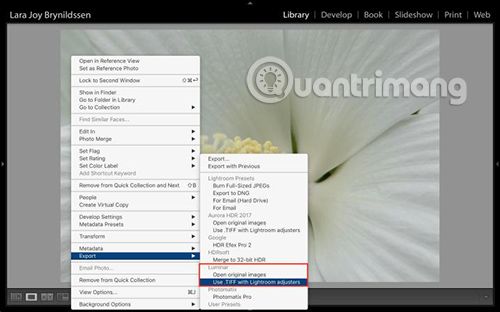
Note : You can also choose Edit in> Luminar .
If you have adjusted your image in Lightroom, such as adjusting the lens, cropping, straightening, removing points or reducing noise - instead of selecting Open Original Image , select 'Use .TIFF with Lightroom Adjusters' , or Edit in> Luminar and select 'Edit a copy with Lightroom adjustments' among the options.
The main part in Luminar
Top Toolbar (Top Toolbar)
Let's look at the top toolbar inside Luminar. The article will discuss the location of the tools and their functions, but in case you are not sure what each icon plays, move the cursor over it. A small pop-up window will appear and you can confirm that you are looking for the right tool.

Side Panel (Side control panel)
Starting at the top right corner of the Top Toolbar is an icon that allows you to open and close the panel on the Side Panel (this is where you add layers and filters to adjust your image). Many people like to work with Side Panel open, but if you need to see a larger version of the image, click on this icon to turn it off and give yourself a bigger workspace. Click it again to turn on the control panel again.
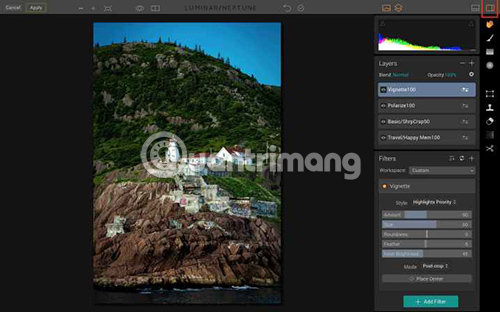
Here, the working space of the Luminar with Side Panel is turned on. Note that if the icon is white, it is turned off. If the icon is orange, it is turned on.
Preset Panel (preset control panel)
The icon for Preset Panel is on the left side of the Side Panel. Again, click on the icon below to turn on and turn off this panel.
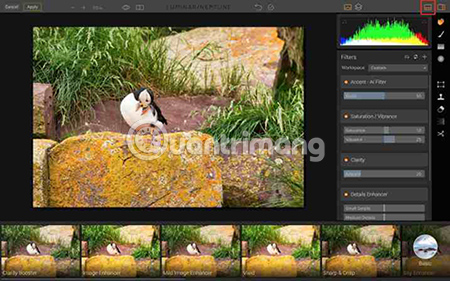
When enabled, the Preset Panel runs along the bottom of the Luminar workspace, giving you a preview of each effect when applied to the image.
Layers and Histogram
The next icon is the Layers panel. It looks like two sheets of paper overlap. Because the focus of this article is on beginner techniques, Layers will not be mentioned here. Just make a quick note of this icon's location so that when you need it, you'll know how to find it.
To the left of the Layers icon is the Histogram icon.

The Histogram icon highlighted here is in red, on the right is the Layers panel. Currently the Layers are turned off so it is gray.
Histogram itself has two triangles that can be clicked on and off. The orange triangle shows this feature is turned on. These warnings on these triangles indicate that your image has any highlights (white) overexposed or underexposed black (black) shadow points. If this is the case, they will call the corresponding red or green on the image.
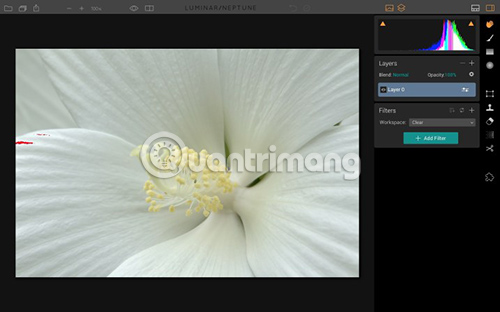
History (history)
Click the small clock icon to see the history of all the changes you have made to your image. If you're not sure what you like, click on any previous step to return to the desired point.
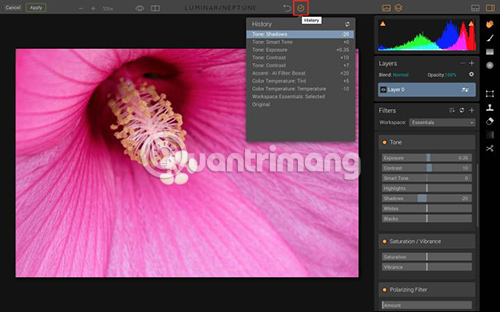
Undo
The curved arrow to the left of the History icon will undo the last step you took.
Compare (compare)
One of the favorite Luminar features, Compare is a small icon to the right of the eye. When you activate the comparison frame, you can slide the line separating the image before / after editing to see how your adjustments affect the overall appearance of the picture.
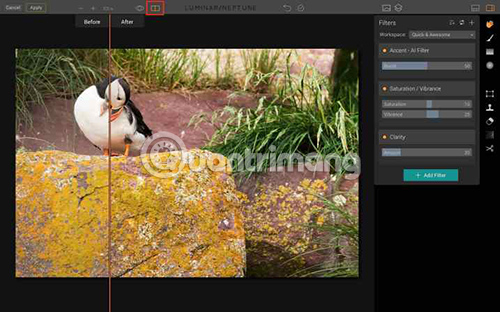
Preview (Preview)
The eye icon can be turned on and off to quickly show you the original compared to the edited image.

Zoom icon
There are 4 Zoom icons. You can switch between 100% and Fit to Screen or make resizing by using the + and - icons.
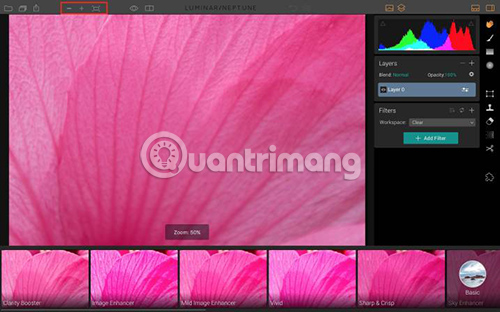
Side Toolbar (Side Toolbar)
At the bottom right is a list of more advanced tools, so the article won't go into them. However, the Crop Tool, a crop icon, is part of almost every workflow.
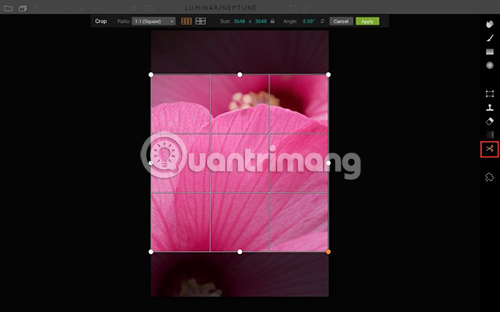
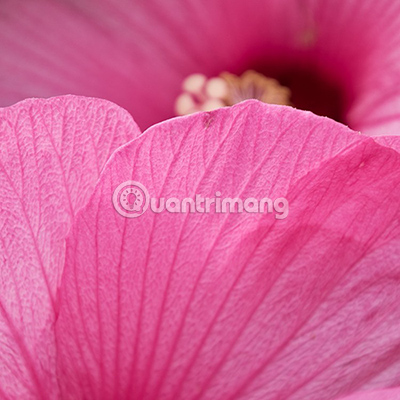
Edit photos in Luminar
Filters (Filters)
Now, you know where all the tools are. Next, let's talk about how to use them to adjust your image.
Luminar calls each regulator a Filter . For example, the Filter contains adjustable sliders, Exposure, Contrast, Whites, Blacks (exposure, contrast, white, black areas), etc. Some filters, such as Polarizing filters , contain only one thing. correction.
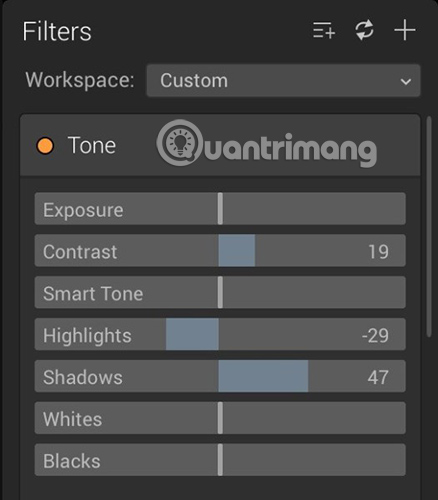
To add additional filters to the image, click the + to open the flyout menu, scroll through it, select the filter you need and then adjust the slider.
Note : If you click on the name of the filter, it will be added and the flyout menu will close. But if you want to add more filters, just click the small + sign at the end of the filter name. The filter will then be added and keep the menu open so you can add more options.
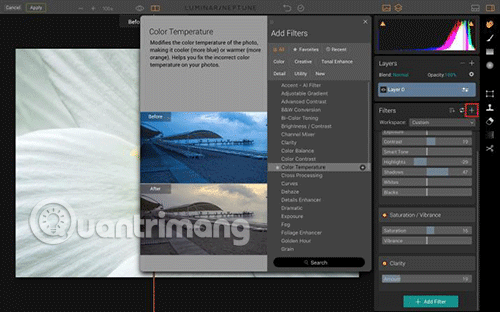
Workspace (Workspace)
Luminar offers quite a number of different filters and while you are still in the process of learning about it, you may not know which filter is best to add to your image. One of the ways that Luminar helps you narrow things down is to provide Workspace options. For example, suppose your image is monochrome (or you want it to be monochrome), you can choose B&W Workspace as the starting point. If it's a landscape picture, select Landscape Workspace.
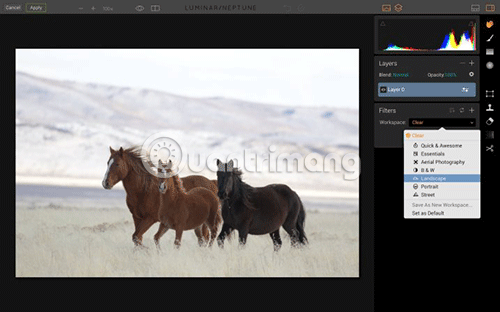
Filters included in each workspace have been selected to enhance only the type of image you are working with. Adjusting each slider can be done according to your needs.

If you have never used Luminar before (or have, but failed), start with Quick and Awesome Workspace . With some images, applying the Accent-AI Filter is all you need to do. Enable Compare so that when you adjust this filter, you can see what it is doing. Add Saturation, Clarity and Vibrance if needed. What does everything look like? If you still need additional adjustments but are not sure which modifications to apply, this is the time to try the presets.
Preset
Presets are similar to Workspace because in each preset there is a set of filters selected. However, the preset in Luminar allows adjusting the sliders (or placing them in advance) to create a unique look. Normally preset's name will give you an idea of the interface that the preset will create.
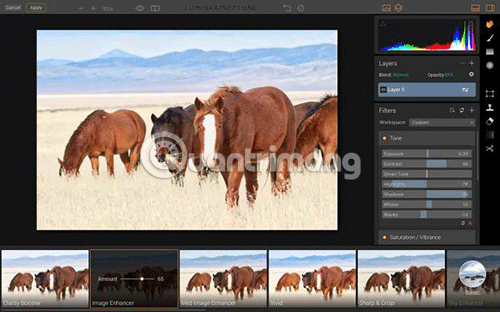
One of the favorite parts of presets in Luminar is the ability to adjust their Opacity. In the image below, the Image Enhancer Preset looks a bit too strong. Dragging the Opacity slider to reduce opacity to 65 is a perfect and easy solution.

4 favorite presets
If you are not sure where to start or choose which preset, here are 4 favorite items:
- Happy Memories in Travel.
- Warm Sunset in Travel.
- Bright Day in Outdoor.
- Mild Image Enhancer in Basic.
To locate presets, click the Preset menu icon in the lower right corner of the interface, then click through the selections in each category. When you find yourself using the same setting repeatedly, add it to Favorites so you can locate it faster. Just click the star icon on the preset to add it to the Favorites list .

Apply presets by using Compare
To select the appropriate preset for your images, scroll through them with the Compare preview panel enabled. When you click on each preset, you will see both your original image and the new image after applying the 100% preset. That will help you learn how each preset affects your image and ultimately, find your own favorites.
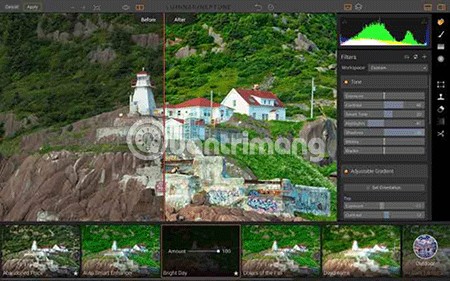
Refine presets
If the preset you choose for images looks nice but not perfect, remember that you can tweak them. Once you apply them, you can reduce the opacity. You can also adjust individual sliders or add and delete filters in the Side Panel.

Save your image
If you start in Luminar, have completed the work on your image and want to create a JPG file, select File> Export to image , then select the correct folder and rename the file accordingly.
If you plan to continue working with the image or you may want to make changes in the future, select File> Save As to create the original Luminar file, then select the folder and rename the file accordingly. This option will retain any layers you have used as well as the edit history ( History ).
Save your image to the Lightroom catalog
If you have started in Lightroom, the application will quickly save your image. After you have finished processing your image in Luminar, click the Apply button in the upper left corner of the interface. This will save your image and also catalog it in Lightroom (in the same folder as the original image).
Hopefully, you can handle some images in Luminar after reading this article. Now, take a minute to upload your best picture and let everyone know about how you created it in Luminar in the comment section below!
Hope you are succesful.
You should read it
- How to use Luminar AI for beautiful landscape shots
- How to restore old family photos with Luminar Neo
- Instructions on how to use Outlook from AZ for beginners
- Instructions on how to play Minecraft for beginners
- How to play Palworld, Palworld guide for newbies
- Instructions for using Dropbox
- Instructions for using OneNote note software for beginners
- Detailed instructions on how to install Windows 7 for beginners
May be interested
- How to play Balatro game for beginners
 balatro is a card game that combines strategy and luck, giving players an exciting experience. for beginners, getting used to the mechanics and gameplay can be difficult. here is a detailed guide on how to play balatro for beginners.
balatro is a card game that combines strategy and luck, giving players an exciting experience. for beginners, getting used to the mechanics and gameplay can be difficult. here is a detailed guide on how to play balatro for beginners. - Guide to playing God of War for beginners
 god of war guide for beginners, important tips to remember when playing god of war for beginners, help the journey of father and son kratos and atreus
god of war guide for beginners, important tips to remember when playing god of war for beginners, help the journey of father and son kratos and atreus - Instructions on how to set the Valorant mouse from A to Z for beginners
 before embarking on the gun battle, beginners do not forget to learn how to set valorant mouse according to the instructions below.
before embarking on the gun battle, beginners do not forget to learn how to set valorant mouse according to the instructions below. - Tips for playing Inscryption for beginners
 inscryption tips for beginners, inscryption tips and strategies to help beginners get acquainted with the game and get a head start
inscryption tips for beginners, inscryption tips and strategies to help beginners get acquainted with the game and get a head start - Instructions to play Apex Legends Mobile Season 1 for beginners
 apex legends mobile is a completely new version on the mobile game market. as a result, beginners may have a hard time getting started in an unfamiliar world with different rules than the usual survival genre.
apex legends mobile is a completely new version on the mobile game market. as a result, beginners may have a hard time getting started in an unfamiliar world with different rules than the usual survival genre. - How to mine Bitcoin and earn Bitcoin for beginners from A to Z
 bitcoin is the virtual currency with the greatest value today. however, to earn bitcoins you need to use a computer to mine them on software. this takes place completely automatically. therefore, if you are new and are learning how to mine bitcoin, you can refer to the detailed instructions in the article below and follow along.
bitcoin is the virtual currency with the greatest value today. however, to earn bitcoins you need to use a computer to mine them on software. this takes place completely automatically. therefore, if you are new and are learning how to mine bitcoin, you can refer to the detailed instructions in the article below and follow along. - How to use Photoshop from az for beginners
 how to use photoshop from az for beginners. photoshop is a professional photo editing software that is trusted and used by many image designers. is integrated all the unique photo editing features through human creative hands will
how to use photoshop from az for beginners. photoshop is a professional photo editing software that is trusted and used by many image designers. is integrated all the unique photo editing features through human creative hands will - How to use iTunes for beginners
 how to use itunes for beginners. itunes is apple's software that allows connectivity between computers and mobile devices such as iphone / ipad / ipod. with itunes, we can copy music, videos, data from pc to iphone / ipad / ipod. in addition, itunes stork
how to use itunes for beginners. itunes is apple's software that allows connectivity between computers and mobile devices such as iphone / ipad / ipod. with itunes, we can copy music, videos, data from pc to iphone / ipad / ipod. in addition, itunes stork - Arknights tips for beginners
 arknights tips for beginners, tips and tricks arknights players need to know to have a strong squad, make a better start.
arknights tips for beginners, tips and tricks arknights players need to know to have a strong squad, make a better start. - Instructions for using Dropbox
 guidelines for using dropbox, if you do not know anything about dropbox, you can start using dropbox immediately after referencing the article below. posts instructions to use dropbox for beginners.
guidelines for using dropbox, if you do not know anything about dropbox, you can start using dropbox immediately after referencing the article below. posts instructions to use dropbox for beginners.










 Guide to blending clouds into beautiful and simple photos
Guide to blending clouds into beautiful and simple photos Tools that enlarge images without breaking the image
Tools that enlarge images without breaking the image How to adjust Mazda lips, lip wings swallow on the phone
How to adjust Mazda lips, lip wings swallow on the phone How to do a plane ride for an old woman
How to do a plane ride for an old woman 5 best GIF creation apps for iPhone, Android
5 best GIF creation apps for iPhone, Android